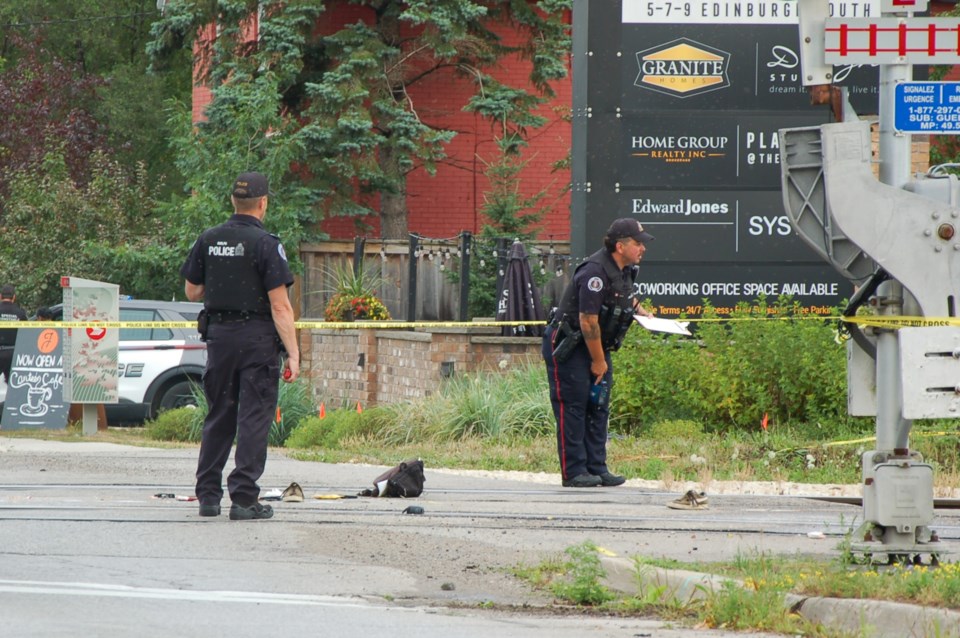Safety improvements may be on the way at the Edinburgh Road site where a cyclist was struck and killed by a train last summer, but they aren’t warranted for other at-grade Metrolinx rail crossings in Guelph, city staff believe following a review of them all.
In a report to council expected next month, staff is set to recommend launching an environmental assessment of the Edinburgh Road crossing, between Foster Avenue and Preston/Inkerman streets, to investigate potential safety enhancements such as an under or overpass and come up with a preferred option for council to consider.
“The other locations are all local streets that didn’t meet the warrants and didn’t have the volume thresholds or the safety concerns that would justify the need to do further study or looking at grade separation,” said Jennifer Juste, the city’s manager of transportation. “The one main intersection we want to look at is Edinburgh Road.”
The Edinburgh Road crossing is the one where a cyclist died last August after colliding with a train. According to a police news release at the time, a southbound cyclist went around the barrier for "an unknown reason" and was struck by a westbound train.
Should council agree to launch an environmental assessment of the crossing, the study won’t look at the non-Metrolinx rail lines to the north, where shunting trains frequently disrupt the flow of traffic for several minutes at a time near the Paisley Road intersection.
That crossing wasn’t part of the recent review either, but it is the subject of negotiations between city officials and Canadian National Railway with the goal of alleviating traffic-related concerns there.
The recent review of Metrolinx crossings also looked at Alma Street (between Crimea and Inkerman streets), Yorkshire Street (between Foster Avenue and Preston Street), Glasgow Street at Kent Street, and Watson Road, just north of York Road.
According to Juste, those crossings don’t meet the Transport Canada thresholds regarding their “exposure index” – a calculation that factors in the number of times per day a train crosses the road as well as road traffic volumes – and the impact of vehicles blocking driveways and intersections as drivers wait for trains to pass.
“Ultimately, the railway company is the owner and operator of that facility and it’s their responsibility to maintain the crossing and the warning system, stop signs and all of that,” said Juste. “We own the road. We own approaches to the crossing on either side, so we need to coordinate with them.”
Numerous requests to discuss roadway crossing safety issues with Metrolinx officials were not successful.
The Edinburgh Road crossing in question shares much in common with one in Kitchener that was the subject of a Transportation Safety Board (TSB) safety alert issued last week. That crossing saw two pedestrians severely injured when they were struck by a train in 2019.
“This accident illustrates the critical and pervasive issue of railway crossing safety, which is the second leading cause of fatalities in the railway sector,” explains TSB chair Kathy Fox in the alert notice. “Crossing safety is a shared responsibility. Pedestrians and motorists need to obey the rules at crossings; and the railways, road authorities and regulator need to communicate with each other when risks are identified and take appropriate action to improve safety and prevent further crossing accidents.”
Both the Kitchener and Edinburgh Road crossings include multiple sets of track, flashing warning lights and gates that block road traffic when a train nears but don’t obstruct sidewalks.
There are differences too.
“The one in Kitchener has way higher pedestrian volumes,” Juste said, adding the most significant difference is that trains don’t block Edinburgh Road in order to switch tracks as they do at the Kitchener crossing – something that’s been deemed to be a factor in that collision.
Believing the gates and flashing lights to be related to a slow-moving train switching tracks, the pedestrians crossed without seeing a second train coming, as explained in the TSB alert. It was that second train which struck the pedestrians.
“That situation isn’t likely to happen at Edinburgh Road,” said Juste. “That’s good news in the sense that we don’t have quite the same risk presented at that location, but we certainly want to know as best we can from Metrolinx what their plans are in the future for continuing to do their infrastructure improvements along the corridor.
“We continue to advocate for safety” when speaking with Metrolinx officials, she said.
GO train speeds within the city increased in 2021 as Metrolinx works toward its stated goal of establishing all-day, two-way service between Guelph and Toronto.
The trains, which were initially limited to travelling through the city at 16 km/h, increased speeds to 32 km/h in October of 2021 and again increased to 48 km/h that November before the final increase to 72 km/h the following month.
“There comes a point upon which personal responsibility takes over municipal, federal or provincial liability,” said Andrew Wray, a doctoral candidate in the geography department at Western University, who reviewed information about the Kitchener and Edinburgh Road crossings before commenting.
“No matter whether you think it’s malfunctioning or there isn’t a train coming, I can assure you the vast majority of time those signals are indicating some sort of vehicle is coming (down the track) and you should wait until those signals clear before attempting to cross.”
